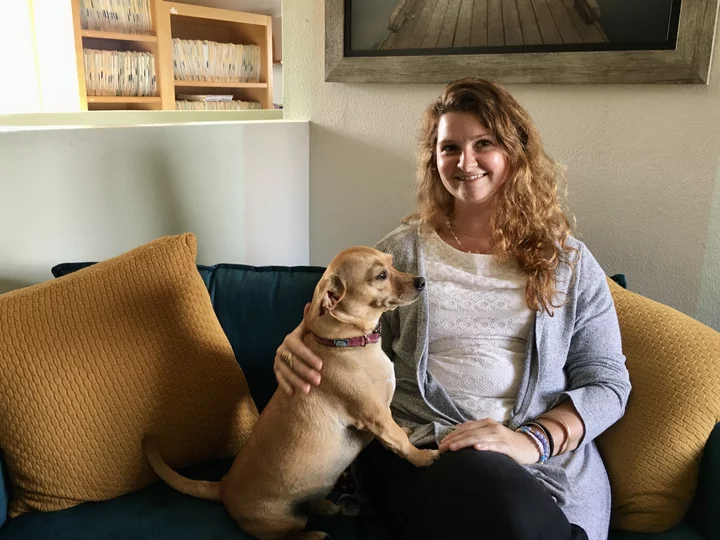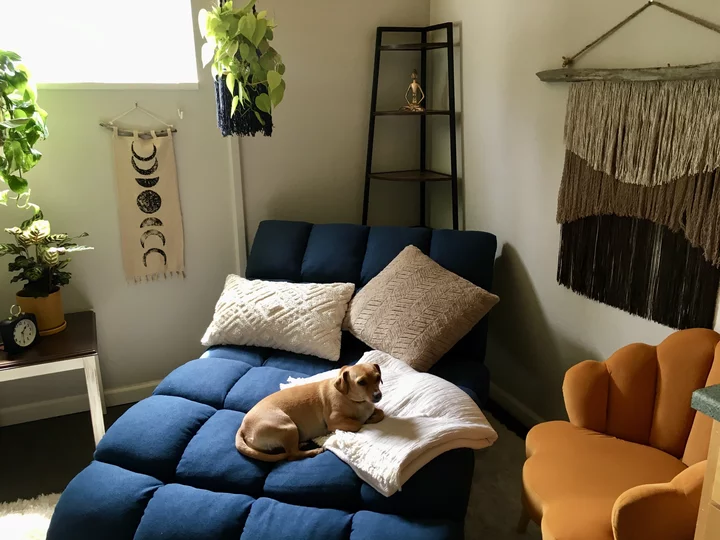Doctor Carrie Griffin and her dog, Ruby at the Center for New Growth in Eureka | Photos: Stephanie McGeary
###
Step into Dr. Carrie Griffin’s office and you might notice that it is not like a usual medical or therapy office. You’ll likely be greeted by Griffin’s tiny dog, Ruby, as you enter the waiting room, before you’re taken to one of the treatment rooms, adorned with cozy couches, velvet chairs, plants, pillows and blankets.
The reason behind this inviting decor is that Griffin’s office – the Center for New Growth in Eureka – is meant to offer a safe and pleasant environment for patients to … well … trip.
The Center for New Growth is the first, and so far the only, facility in Humboldt County to offer ketamine-assisted therapy, administering ketamine – a drug that is used as a medical anesthetic, and has also been a popular party drug – as part of their treatment, usually along with talk therapy. Ketamine-assisted therapy has recently been growing in prominence, with many medical professionals endorsing its efficacy in treating depression, anxiety, drug addiction and post-traumatic stress disorder (PTSD).
“Part of the benefit of ketamine-assisted psychotherapy is that you’re in one of these treatment rooms and you’re in a place where someone is there to fully attend to you,” Griffin told the Outpost during a recent interview. “We get that so rarely in our lives, and so many of us didn’t really receive it at the moment developmentally when we most needed it in those first five years of our childhood. So just having that capacity to have someone who is with you, attuned to you, tending to you, can be pretty transformative in and of itself.”
Griffin started working in the space in 2018 when it still held its previous clinic, With Open Arms Reproductive Care Services, which focused on reproductive and maternity care. Griffin specialized in prenatal substance use, which led her to work with many patients who suffered from some kind of trauma. When the clinic went under in 2020, Griffin started running her own private practice out of the space, offering trauma therapy and osteopathy. In 2021 Griffin added ketamine-assisted therapy to her list of services. Recently Griffin began transitioning to only offer ketamine therapy and built up her staff. She added Mariel Bosserman, a nurse practitioner, Melissa Sandeen, a psychotherapist, Randee Litten, a registered nurse, and Armida Martinez, the office manager, to the staff, and the Center for New Growth was born.
So, how exactly does the process work? Well, if you are interested in pursuing ketamine therapy treatment and reach out to the center, the first thing you’ll be scheduled for is a consultation call. During this call, Griffin said, staff is trying to get a better understanding of what is going on with you and whether ketamine therapy would be right for you. You will be asked questions like, What are you wanting for yourself? What is it about ketamine therapy that’s drawing you to this treatment? What other types of treatment have you tried? What kind of diagnoses have you received?
The next step is coming into the office for a medical clearance exam, to make sure you don’t summer from any medical issues that need to be addressed before you can move forward with ketamine therapy. The main thing they are screening for, Griffin said, is uncontrolled hypertension (high blood pressure) because ketamine can raise your blood pressure.
After your medical exam, Griffin said, you will have your prep session, when you discuss what it is you are looking to work through and how altered of a state you feel comfortable reaching. The providers will then determine what the best method is for your treatment. For a less intense experience, Griffin can prescribe ketamine lozenges – which will be filled by a local compounding pharmacy – and can be taken at home. But if you are interested in a psychedelic level of dosing (and the providers determine that is the right method for you), you will receive the drug either intramuscularly or intravenously in one of the treatment rooms at the office.
If you are going the injection route with your ketamine, a little more preparation will be needed. First, you will be asked to avoid eating for at least a few hours before your appointment, as nausea is the most common side effect of the treatment. The doctor or therapist will then talk to you about what you are feeling right now, what you are hoping to get out of the treatment and any fears you may have about entering your “expanded state,” Griffin said.
You will then move into one of the medical treatment rooms, where your blood pressure will be taken. You will also receive anti-nausea medication, if you want it (Griffin said it is strongly recommended because nausea is a common side effect). You will then be given eye shades and headphones to block out the images and noises of the outside world. Music will be played through the headphones and in the treatment room – usually music that the staff has recommended for your session.
Once you’re all settled in, you will receive your injection and … blast off. The change will happen pretty quickly. With an intramuscular shot, you will start to feel the effects in as soon as two minutes. Surprisingly, intravenous takes a little bit longer – between five and eight minutes, Griffin said. The dosage amount you receive varies depending on body weight (generally, .5 to one milligram per kilogram of weight.) But dosing will also depend on how much prior experience you have with psychedelics and how far out you’re looking to go. Most often, Griffin said, a first-time patient will be started with the lowest treatment dose.
One of the treatment rooms at the Center for New Growth
The ketamine experience generally lasts around 45 minutes and patients are usually in a pretty non-verbal state during this time, Griffin said. The ketamine experience varies from person to person, but often involves a sort of out-of-body experience. Emily Witt, in her New Yorker article “Ketamine Therapy is Going Mainstream. Are We Ready?” explained her experience of coming onto ketamine like this: “My mind dissolved into a muted silence, as though I were in a warm, carpeted soundbooth.”
Later ,Witt wrote, “before taking the shot, I had been sad and worried. I emerged feeling calm and soothed.”
And feeling calmer, happier and more at ease seems to be a common reaction to the ketamine treatment. Sometimes that feeling lasts for a couple of days, other times weeks. Many people find it to be an extremely effective antidepressant in this way. Ketamine is often recommended to those who have “medication resistant depression,” Griffin said, meaning that they have not found other medications, such as SSRIs to be helpful in treating their depression.
The reason ketamine can be more effective for some people is that it behaves differently than other antidepressants. By blocking glutamate receptors, it increases glutamate globally throughout the brain. Ketamine also improves neuroplasticity and stimulates the brain’s glial cells, which are the cells that provide support for the brain’s neurons.
In addition to the benefits ketamine can have on the brain, Griffin said that it can make patients more open with their emotions, making talk therapy more effective. It also provides an opportunity for some people to address traumas from their past by reliving experiences in a safe way. The treatment often puts people into “witness consciousness,” Griffin said.
“You get to watch yourself from a different vantage point,” she said. “I’ve watched people and listened to people relive experiences of being raped, or sexually abused, of finding loved ones or family members down and having to do CPR on them at the moment, or they lost their children. And they relive them right here.”
Of course, reliving a traumatic experience can potentially be extremely frightening. This is one of the ways having a therapist, or guide, present can help. If people seem to be having too intense or uncomfortable of an experience, the guide can help serve as an anchor to reality. “[We’ll say things] like ‘you’re here, you’re safe, you’re in Eureka, California,’ you know, like ‘we’re with you, you’ve got this’…”
Typically, as the patient starts to land from their trip, the therapist will engage with the patient and help ease them back into reality. As the person begins to become verbal again, the therapist will begin to ask about images, words or sensations the person is bringing back with them from their journey. The therapist will also discuss what they observed during the patient’s experience, what was happening with their body and their breathing and will share things the person might have said during their trip and discuss this with the patient.
Of course, ketamine-assisted therapy is not for everyone and there are potential risks associated with it, including addiction. Problems with ketamine addiction became more prominent as it became a popular club drug in the 90s, especially in the UK . And its recreational use as a party drug seems to be on the rise again over the last few years. But Griffin stresses that the ketamine being administered in a treatment center is usually very different from what a person would get on the street, where it is often cut with other substances. If a person is only taking ketamine as prescribed, then the risk of addiction is very low, Griffin said. Drug-seeking behavior is also something the center screens for.
High levels of ketamine use can also lead to cystitis, or inflammation of the bladder. This usually only occurs when someone uses large amounts of ketamine (around six grams a day), Griffin said. Again, if you are only using the drug as directed, this should not be a problem.
So, what makes someone a good candidate for ketamine-assisted therapy? As mentioned before, Griffin recommends this option if you have treatment-resistant depression – meaning you have tried at least three different treatment options that have been unsuccessful, or if you suffer from PTSD. Griffin said that ketamine therapy can also be effective in relieving postpartum depression or grief. Griffin also mentioned that there is a burgeoning body of evidence that ketamine can be effective in treating alcoholism or other substance use disorders.
Before you consider ketamine therapy, you should also be aware that it is not cheap. Griffin does operate on a sliding scale, offering a ketamine-assisted therapy session for between $450 and $750. The center does partner with a medical micro-loan service, which offers an up-front loan and two years of zero percent interest in order to help people who can’t cover the cost upfront. But, unfortunately, insurance does not cover the treatment in California. Because ketamine’s primary legal use is as an anesthetic, psychotherapy and depression treatment is still considered an off-label use and is not covered by insurance. This is beginning to change, however, as more states and medicaid programs recognize the benefits of ketamine in treating depression.
And as psychoactive substances are becoming more widely recognized as a therapeutic resource, Griffin is hopeful that ketamine assisted psychotherapy will be covered by more insurance programs and will become more accessible to lower-income individuals.
“My greatest tension around this work right now is the fact that this care that I have witnessed to be so profound and so transformative and effective, doesn’t fit into the current system of how care is rendered,” Griffin told the Outpost. “And I do not even pretend to have the answer at this point about how to solve this. But I will say that I feel more committed to this piece of equity and access than perhaps any other part of the practice. I really want this to be accessible.”
The center at 2505 Lucas Street, Suite B, previously With Open Arms



CLICK TO MANAGE